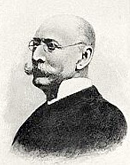

Antonín Viktor Barvitius
*14. 7. 1823 – Prague, Czech Republic
†20. 7. 1901 – Prague, Czech Republic
Biography
Antonín Viktor Barvitius was a Czech historicist architect and applied arts designer. He came from the family of the treasurer of the Count Buquoy's, Andreas Barvitius, and his wife Barbara, née Egger. He was the oldest of nine children, the painter Viktor Barvitius (1834-1902) being the youngest among them. In 1840, he enrolled at the Charles University in Prague to study philosophy and law. However, in 1843, he entered the Painting Academy in Prague into the monumental painting studio of Christian Ruben, where he transferred after 1844 to study architecture under Eduard van der Nüll, August Sicardsburg, and Karl Roesner at the Academy of Fine Arts in Vienna. After several years of work in Vienna, in 1854 he went on a scholarship to Rome, where he engaged in the restoration of Renaissance monuments. His most significant commission was the restoration of the Austrian residence Palazzo di Venezia. After returning to Prague in 1867, he collaborated for some time with his brother-in-law Vojtěch Ignác Ullmann. Barvitius and Ullmann brought the Viennese architectural style known as Rundbogenstil to Prague. This "administrative" style was widely used for the construction of schools, courts, barracks, etc., but was not suitable for representative buildings. Antonín Barvitius later successfully worked for the Christian Academy – Fine Arts Department. For the academy, he created a number of designs for goldsmith works of liturgical vessels, predominantly monstrances, as well as book bindings, etc.
Antonín Viktor Barvitius was a Czech historicist architect and applied arts designer. He came from the family of the treasurer of the Count Buquoy's, Andreas Barvitius, and his wife Barbara, née Egger. He was the oldest of nine children, the painter Viktor Barvitius (1834-1902) being the youngest among them. In 1840, he enrolled at the Charles University in Prague to study philosophy and law. However, in 1843, he entered the Painting Academy in Prague into the monumental painting studio of Christian Ruben, where he transferred after 1844 to study architecture under Eduard van der Nüll, August Sicardsburg, and Karl Roesner at the Academy of Fine Arts in Vienna. After several years of work in Vienna, in 1854 he went on a scholarship to Rome, where he engaged in the restoration of Renaissance monuments. His most significant commission was the restoration of the Austrian residence Palazzo di Venezia. After returning to Prague in 1867, he collaborated for some time with his brother-in-law Vojtěch Ignác Ullmann. Barvitius and Ullmann brought the Viennese architectural style known as Rundbogenstil to Prague. This "administrative" style was widely used for the construction of schools, courts, barracks, etc., but was not suitable for representative buildings. Antonín Barvitius later successfully worked for the Christian Academy – Fine Arts Department. For the academy, he created a number of designs for goldsmith works of liturgical vessels, predominantly monstrances, as well as book bindings, etc.
The English translation is powered by AI tool. Switch to Czech to view the original text source.












